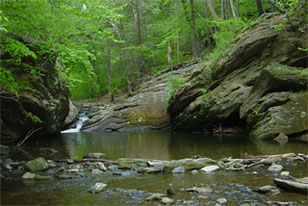Fairmount Park Restoration

Natural Lands Restoration & Environmental Education
In an unprecedented effort to restore, renew, and protect one of the largest municipal parks in the U.S. for future generations, the Fairmount Park Commission selected The Academy of Natural Sciences to work on the Natural Lands Restoration and Environmental Education Program (NLREEP). This five-year special initiative was initially funded by a $26 million grant from the William Penn Foundation, characterized by a spokesperson for the Park Commission as the largest single gift granted by a private foundation to a public park or recreation agency in the country. Since its inception, NLREEP has coordinated volunteer restoration activities by a number of groups and has received additional grants for specific restoration projects. The Academy's team involved the Environmental, Systematic biology and Public Programs Groups of the Academy and scientists from the Morris Arboretum and the Natural Lands Trust and was led by the Patrick Center for Environmental Research.
NLREEP is designed to restore portions of the natural landscape in the seven watershed parks of the Fairmount Park system, including the Wissahickon Park, Cobbs Creek Park, East and West Park, FDR Park, Pennypack Park, Poquessing Park, and Tacony Park. The grant funds have also allowed expansion of the environmental education program in the park.
Master Plan
The Academy prepared the master plan for environmental restoration in the park system. The master planning process included assessment of vegetative health and invasive plants throughout the park, assessment of stream conditions in the many streams within the park system, review of historical information on ecological conditions, compilation of historical records of flora and fauna, and extensive inventory of flora and fauna of the park. Public meetings were held with community groups throughout the city to document local community interests and needs, and to discuss potential restoration activities.
The master plan documented important ecological sites throughout the park system and described a variety of restoration activities which should be implemented and made site-specific recommendations for restoration. Recommended activities include invasive plant control and revegetation by native plants, creation of meadows and wetlands to reduce stormwater runoff and increase wildlife habitat, construction of berms and other techniques to increase infiltration, repair of erosion gullies and erosion control to reduce erosion, bioengineering approaches to stream bank protection, improvements of trails, stream crossings, and culverts to reduce bank erosion, and reintroduction of selected animal taxa. Many of these activities have been implemented following preparation of the master plan.